(serves 5-6)
This is essentially a deconstructed Lobster Thermidor served chilled, containing all the key ingredients of the hot version – lobster, wine, mushrooms, onions, cream and cheese. Morel mushrooms make up for the flavour that comes from the grill while the whipped cream and Parmesan provide the structure to hold the dish together. It makes for a great lobster appetizer that is neither greasy nor filling like the original.
Ingredients
- Lobster Tails (500g)
- Dried Morel Mushrooms (1 cup)
- Grated Parmigiano Reggiano (1/3 cup)
- Onion (1)
- Whipping Cream (300 ml)
- White Wine (1/3 cup)
- Butter
- Paprika
- White Pepper
- Tarragon
- Chopped Parsley
Preparation
- Defrost and remove the shell of the lobsters. Brine the meat in a solution of 1T salt and 1t sugar in 2 cups of water for 20 minutes.
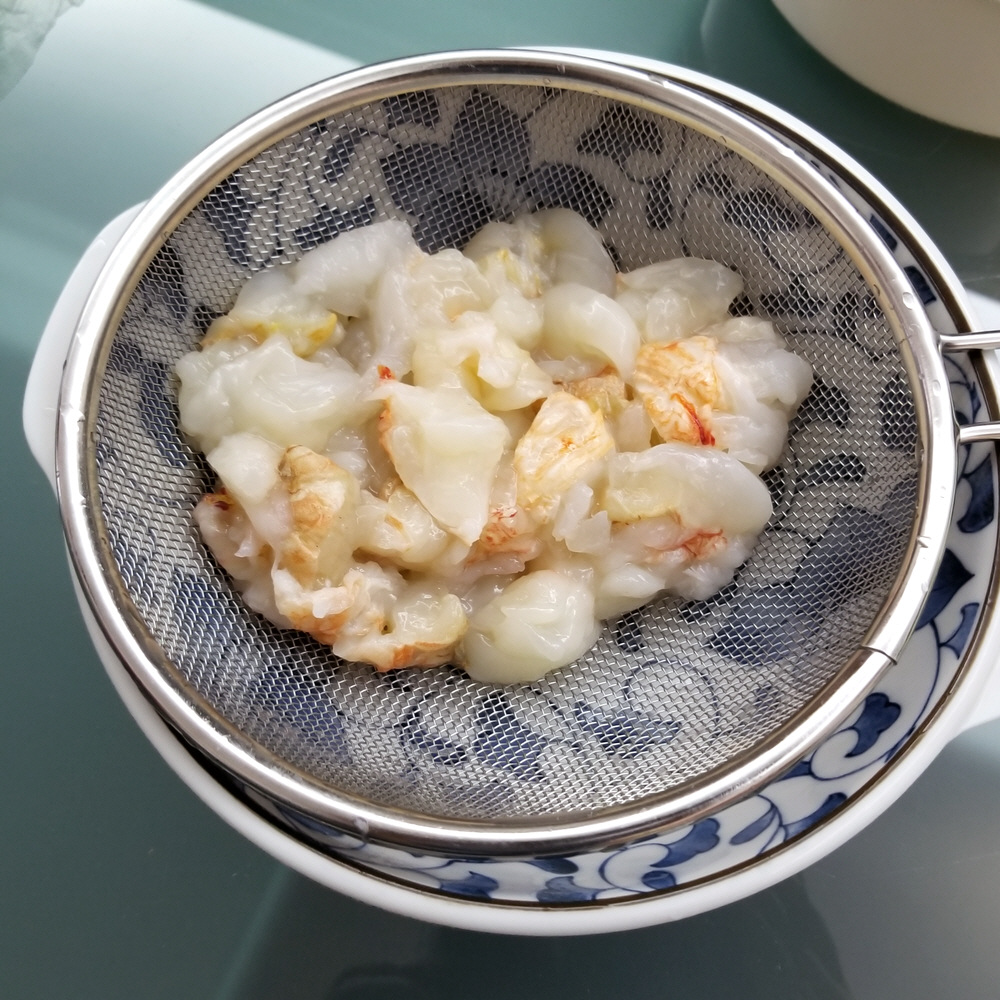 Cut the lobster meat into bite sized morsels. drain off all the excess brine by leaving the lobster meat in a strainer.
Cut the lobster meat into bite sized morsels. drain off all the excess brine by leaving the lobster meat in a strainer.
- Soak 1 cup of dried morel mushrooms in 1 cup of water, until the mushrooms are soft. Squeeze the morels like a sponge to remove excess liquid, but keep all the soaking liquid for later use.
- Finely grate 1/3 cup of Parmigiano Reggiano.
- Dice one onion into 1/4 inch pieces.
- Add a large knob of butter to large pan, and pan fry the onions on low heat until they begin to soften.
- Add a second large knob of butter and the morels. Stir fry for a further minute.
- Turn up the heat and add the lobster followed by a light sprinkle of white pepper. Stir fry until the the lobster is no longer translucent, then add 1/3 cup of white wine together with 1t of chopped tarragon. Bring back to simmer and turn off the heat.
- Pour the contents of the pan into a strainer with a bowl below to catch the excess liquid.

- Return the liquid to the pan. Add the morel water, 1t sugar and bring to a boil. Then sprinkle on the grated parmesan and stir until all the sheese has melted. Simmer the liquid down to half a cup. Pour the liquid into a cup.
- Pour the cheese wine mixture into a cup and and allow to cool to room temperature. The lobster and mushrooms need to be cold, so place them into the fridge in a ziploc bag.
- Pour 300 ml of cream into a container and whip until it forms stiff peaks. Then pour in the (room temperature) cheese wine liquid, add 1 flat t of paprika and fold until they combine completely. If you are using a hand held blender, you can use a three second pulse on low speed.
- Pack the (cold) lobster and mushrooms snugly into wine glasses (or some other serving container) and top off with the mousse. Garnish each serving with a pinch of finely chopped parsley.
- Cover the mouth of each glass with cling film and leave in the fridge to chill until it is time to serve.
Notes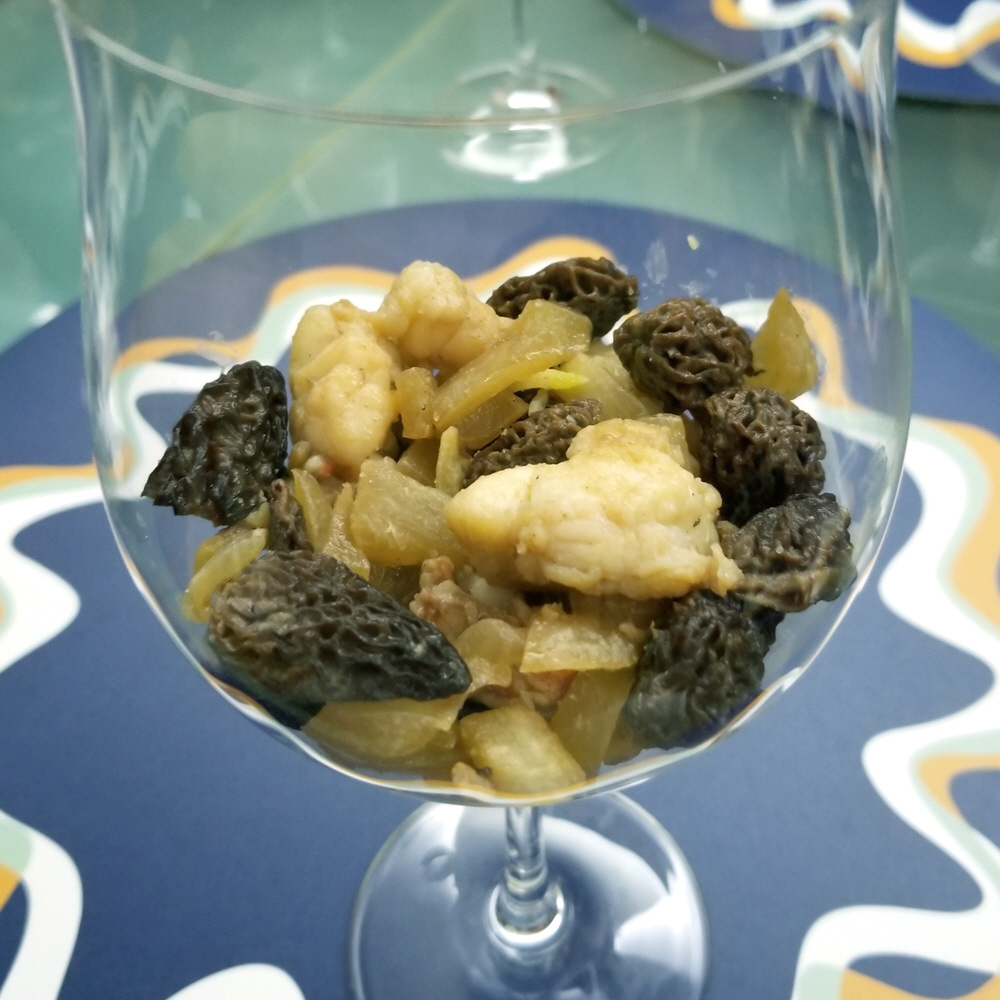
- Most recipes use gelatin powder as the solidifying agent for savoury mousse but parmesan cheese brings with it an additional level of umami flavour and tastes more natural.
- There’s no point in using the more expensive large lobster tails. FOr 500g, 4 small lobster tails will do the job nicely.
- If you are pressed for time, you can put the ziploc with the cooked lobster in the freezer for 15 minutes. For the liquid, you can put the cup in an ice bath.
- The best way to put the mousse into wine glasses is to push the mousse off a table spoon using a tea spoon. Let the mousse drop dead center into the glass without touching the sides of the glass. You can flatten the mousse using a tea spoon as you rotate the glass.
- If you don’t have any morel mushrooms, you can substitute with another kind of dried mushroom (like Porcini). Don’t use fresh mushrooms.
- Remember to wash the strainer before you reuse it in step 8 as it has previously held raw lobster meat.
Tags: Cream, lobster, Morel, Mousse, Parmigiano-Reggiano, Wine
(serves 3 to 4)
Miso Stew or Miso Nabe is a winter dish that is popular in Hokkaido. The concentration of protein and carbohydrates in miso and soya milk creates a stew that is hearty and robust, giving it the power to keep the cold at bay. Every region has its own unique way of cooking their miso stew and there is no definitive cooking method or set of ingredients, though the meat is usually fish, pork or chicken. If you’ve never tired a Miso Stew don’t worry, my particular way of cooking Miso Stew is suitable to Western tastes.
Ingredients
- Chicken Legs (2, with thigh)
- Red Miso (4T)
- Carrot (1)
- Onion (1)
- Mushroom (1.5 cups)
- Yam (1)
- Garlic (1T, minced)
- Mirin
- Sake
- Soy Sauce
- Soya Milk (unsweetened, 3/4 Cup)
- Maple Syrup
Preparation (the day before)
- Debone the chicken and cut the meat into bite sized chunks. Keep the bones in the freezer for use the next day.
- Mix in a large bowl 2T Red Miso, 2T Sake, 1T Mirin and 1T Maple Syrup until you get a paste. Stir in 1T of minced garlic.
- Place the chicken meat in the bowl and toss well until each piece is coated with the marinade. Cover the bowl with cling film and keep it in the fridge overnight.
Preparation
- Peel a yam and cut it into bit sized chunks. Place the yam pieces on a sheet of aluminium foil and drizzle them with 2T oil and 2T mirin. Wrap the yam up in the foil and place in a toaster oven set at 180oC (360oF) for twenty five minutes.
- Put 3T of oil in a large pan (or clay pot) and heat the pan until the oil is searing hot. Keeping the fire on high, pour in the chicken together with all the marinade. Stir fry.
- When the chicken begins to shrink, add 3/4 cup of soy milk and 3/4 of water. After a quick stir, pick out the chicken pieces and set them aside on a plate.
- When the contents of the pan come to a boil again, put the chicken bones in the pan, as well as 1T sugar, 1T Soy Sauce and 2T of Red Miso. Turn the fire down to bring the liquid in the pan to a low simmer.
- Peel a carrot and slice it into 1/8 inch thick oval pieces. Put the carrot slices in the pan.
- Peel an onion and cut it into 6 equal wedges. Place the onion in the pan. Cover the pan and simmer for about 15 minutes.
- Cut your mushrooms into appropriate size if you have chosen to use a big variety. I used Shimeji in the picture above and used them whole.
- When the carrot is no longer crunchy, add the mushrooms, chicken and yam to the pan. Cover and simmer for a further five minutes. Remove the chicken bones before serving.
Notes
- You’ll notice I specified Red Miso above. You can also use Hatcho Miso, but preferable not any of the white, yellow or golden varieties of Miso, for the unique flavour of miso dissipates into plain saltiness with cooking. For more information on Miso, you can refer to this post about Miso.
- Nabe (pronounced nar-bay) is not the Japanese word for stew. It refers to a shared hot pot, sort of like a fondue using soup.
- If don’t have any unsweetened soya milk, you can use plain milk instead.
- The reason you put in the carrots before the onion is carrot takes longer to soften. Don’t reverse the order of steps 5 and 6.
- One key element of this recipe is cooking the yam and chicken separately from the stew. Both chicken and yam taste better when cooked at high temperatures. You can of course choose to just boil everything in the stew, but the result will not be as good.
- Miso stew is best eaten with steamed rice as a staple, although you can use another type of staple, like noodles or bread. This stew is not meant to be eaten on its own.
- Instead of putting the bones in the freezer, you could also keep them in the bowl with the marinated chicken if it is big enough. A third option would be to boil the bones to create 3/4 cup of stock which you then put in the fridge.
Tags: Carrots, Chicken, Japan, Mirin, Miso, Onion, Soya Milk
(serves 6)
Making a fresh savoury cold appetizer is not easy, but this recipe does the trick. This Mango Shrimp cocktail uses a ‘cocktail sauce’ that contains no tomato or vinegar, even though it looks exactly like the usual shrimp cocktail. The secret comes from using prawn heads and paprika to make the cocktail sauce red instead of tomato sauce. I guarantee your guests will be pleasantly surprised when they taste the first spoonful and find the cocktail is neither sour nor tangy.
Ingredients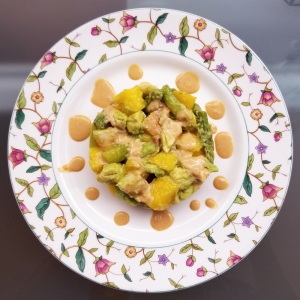
- Mid-sized Prawns (400g)
- Avocado (2)
- Asparagus (8 spears)
- Mango (1 large)
- Minced Garlic
- Mayonnaise
- Milk
- Mustard
- Brandy
- Paprika
Preparation
- Place 2 Avocados into the fridge.
- Cut off the heads of your prawns and snip off the whiskers. Using kitchen scissors, cut the shell of each prawn down the back and pull out the intestines.
- Fry 2t of minced garlic with 1T of oil in a pan on hig heat. When the garlic begins to brown, add the prawn heads and stir fry till they are fully red, then add a cup of water and 1T brandy. Turn the heat down to a simmer. Crush each prawn head with a wooden spatula to release their flavour.
- Add the prawn bodies to the pan and fish them out again when they are curled up and red on both sides. Pour the pan’s contents through a sieve into a bowl.
- Return the reddish prawn stock to the pan. Add 2T mayonnaise, 2T milk, 1t mustard and 1t paprika to the pan. Simmer until the liquid thickens into a thin orange sauce. Put the ‘cocktail sauce’ into the fridge to thicken and cool.
- Peel and dice the prawns. Wrap in cling film and place into the fridge.
- Cut off the bottom quarter of each spear of asparagus and then use a peeler to remove any fibrous skin at the bottom end. Par boil the Asparagus for 2 minutes, you can use the same pan. Cut the asparagus into pieces and place them in the fridge.
- Cut the mango on both sides of the seed. Using a knife, carve a crisscross grid on each of the ‘halves’. With a large spoon, spoon out the mango cubes, one row at a time. Put the mango cubes in the fridge.
- When it is time to serve the shrimp cocktail, halve the avocados and extract the seed using the blade corner (the part next to the handle) of a large knife. Delicately spoon out the flesh and dice. Try not to do this ahead of time as avocado darkens fast when exposed to air.
- Toss the 4 components of your cocktail together in a salad bowl and assemble the mixture on individual soup dishes. Drizzle the ‘cocktail sauce’ over the mixture and serve immediately.
Notes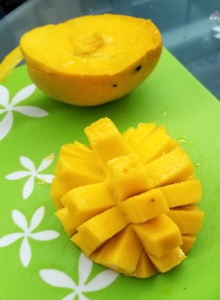
- To make the cocktail more substantial, you can serve it as a salad by adding a bed of shredded lettuce.
- Try to dice everything to similar dimensions. Form a picture mentally of the final result before you start slicing and dicing. For the asparagus consider only the length of each bit as you can’t adjust the diameter.
- One option is to add a flat t of cumin along with the paprika, to add some more heat and give your cocktail a kick. This is the way the French would do it, but its not for everyone.
- Choose your uncooked ingredients carefully. The avocado should be just becoming black for the flesh to be soft. If the avocado is still crunchy to the bite, it is too raw. If it is mushy, then it is too ripe. The mango should be ripe enough that its not sour. Taste both of these before putting them in the fridge, to give yourself the opportunity to procure replacements if necessary.
- Prawns have to be of a minimum size before their heads develop flavour. In spite of the name, you should not use shrimp (i.e. small prawns). For this recipe, individual prawns should weigh no less than 50g (i.e. 8 or less prawns that add up to 400g).
- Going the extra mile: If you want the cocktail to have a nice clean look, you cannot toss the avocado together with the rest of the components as they will ‘grease’ up everything else. The best way to avoid this is to arrange the components separately in stripes like a Cobb salad or like a pie chart. Layering in a wine glass will work as well. Another thing you can do is shock the asparagus in ice water after blanching, to make them a brilliant green.
Tags: Asparagus, Avocado, Mango, Mayonnaise, Paprika, Prawn
(serves 2-3)
This is a recipe for BBQ wings, the type you’d find in a sports bar. For years I tried to cook these wings at home in the same style with limited success. Then one day I discovered the secret to marinating chicken wings. Most recipes use the method of brushing the wings with sauce as you cook them, because its very difficult for flavours to penetrate chicken skin and reach the meat within, but this recipe doesn’t. The secret is counter-intuitive: you have to cook the wings before marinating them.
Ingredients 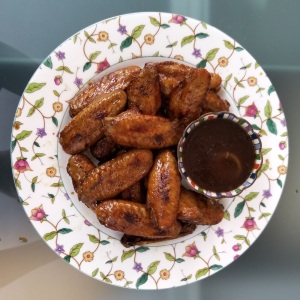
- Chicken Wings (20 mid joint, 700g)
- Shallots (4)
- Garlic (1 bulb)
- BBQ Sauce (1/3 cup)
- Cumin
- Mustard
- Liquid Smoke
- Whiskey
Preparation
- In a medium sized pot, mix 1/3 cup of BBQ sauce with 1.5 cups water, 1t mustard, 1t cumin and 1t salt.
- Peel the garlic and shallots and put them whole into the pot.
- Rinse your chicken wings and add them to the pot.
- Bring the pot to a boil. After 5 minutes of boiling, carefully fish out the chicken wings without damaging the skin. Put the wings in a Tupperware-like of container.
- Continue to simmer the sauce until it has halved in volume. This should take perhaps fifteen minutes. Turn off the heat and stir in 1t liquid smoke and 1T whiskey.
- After the sauce has cooled sufficiently, pour it into the container with the wings. Cover and leave the wings to marinate in the fridge overnight, or in any case for at least six hours. Shake once or twice to allow the marinade to reach between the wings.
- Preheat your toaster oven to 200oC (390oF) degrees.
- Arrange the wings on a wire rack in the toaster oven tray and bake for 25 minutes. You’ll need to do this in two batches as the wings should not touch each other.
- Warm up the leftover marinade in the microwave or in a saucepan. You can serve the wings either with the BBQ sauce separate or coated with the BBQ sauce.
Notes 
- The most important thing you can do is cover your toaster oven tray with foil, so you don’t have to wash off the carbonized BBQ sauce.
- Do not boil the wings for more than 5 minutes. You want the wings to be cooked, but not the skin to soften too much.
- If you are cooking the wings in a full sized oven, it will probably take less than 25 minutes. They are done when you notice dark splotches develop. You can of course also simply cook the wings over a actual BBQ.
- The same method works for all kinds of sauces you might want to flavour wings with, like teriyaki or oyster sauce. Just boil for five minutes and marinate overnight in the fridge.
Tags: BBQ, Chicken, Cumin, Mustard, Toaster Oven
(serves 8)
Otak-otak is a terrine-like grilled fish delicacy from South-east Asia, an exotic spicy dish that works as a western appetizer. There are many varieties of Otak-otak from Thailand all the way down to Indonesia; this version is of the Straits Chinese style featuring coconut milk, popular in Singapore and Penang. Otak-otak is usually grilled in banana leaves and contains other ingredients uncommon in the Western kitchen, but I have worked out a modified recipe that resolves these issues.
Ingredients
- White Fish Fillets (500g)
- Yeo’s Minced Prawns in Spices (2x160g tins)
- Coconut Milk (160 ml)
- Onion (0.5)
- Egg (1)
- White Sandwich Bread
- Lemon
- Cucumber
- Sherry
- Lemongrass
- Tarragon
Preparation
- Dice half an onion and pan fry the pieces on low heat in a pan with a dash of oil. When the onion begins to get limp turn up the heat and add the two cans of minced prawn to the pan and continue frying until you see bubbling. Sprinkle on 2t lemongrass and 1t tarragon and transfer the contents of the pan to a large mixing bowl when it has cooled down.
- Make a brine out of 1T salt, 1t sugar, 1T of lemon juice and 2 cups of water. Cut the fish into chunks and put them in the brine them for 20 minutes (and no more). Rinse and place the fish pieces on a tea towel to dry. You can do this concurrently with step 1.
- Cut 2 slices of plain bread into small cubes. If the bread is fresh and the crust is still soft you can keep the crust, otherwise trim the crust off. Pour in 160 ml of coconut milk over the diced bread followed by 1 egg, 1T of sherry and 1t of sugar. Mix well, then add the fish.
- Place a quarter of the fish and bread mixture in a food processor and give it a 2 second pulse (and no more) on low power. Transfer the resulting fish paste to the mixing bowl with the shrimp and onion. You want the fish paste to be coarse but even, so you cannot blend too much at a time. Repeat another three times to use up all the fish and bread. Stir everything in the mixing bowl until you get an even colour.
- Preheat your oven to 150oC (300oF).
- Pour the seafood mixture into a medium sized casserole dish. The casserole dish should be big enough such that the thickness of the seafood is no more than one inch. Cover the casserole dish, if it doesn’t have a cover you can use aluminium foil snugly crimped over the top.

- Place the casserole in the oven. The idea is not so much to bake the fish but to steam it. After 40 minutes, remove from the oven and allow to cool. There will be bulge in the centre initially but this will flatten over time. What you have now is a seafood terrine of sorts.
- When the terrine is cold, and this can be several hours later or even overnight (in the fridge), put it back in the oven, this time uncovered, for twenty minutes at 200oC (390oF). This will boil off most of the free liquid, refine the aroma and give the Otak-otak a nice crust – as shown here.
- While still hot, cut the Otak-otak into slices and serve on untoasted plain white bread with some thin cucumber slices.
Notes

Yeo’s Minced Prawns in Spices
- As the fish is cooked for an extended time, there is no point in using fresh fish. I typically use frozen pangasius fillets myself , they are cheap and readily available, but really any kind of white fish is fine. The important thing is to dry the fish (draining on a colander is insufficient) properly after brining as the Otak will end up too wet if you don’t.
- Yeo’s Minced Prawn in Spices a.k.a. Prawn Sambal is a key ingredient that contains in a single tin every ingredient you need for cooking Otak you won’t find in your kitchen larder. Last time I checked, you can order it from Amazon. Its not the perfect solution, but its better than looking for weird ingredients like candlenut and galangal.
- If you don’t like your food spicy, you can use just one tin of the minced prawn instead of two (the child’s version I call this), but you’ll need to add salt and sugar to compensate.
- To bring your Otak-otak to the next level, you can add chunks of whole seafood. For example you could brine a few scallops along with the fish, dice them and add them in step 6. Canned or bottled clams would work well also. If you bake cakes and have pandan essence around, a few drops will also do wonders.
- Instead of on bread, you can also serve Otak-otak with some white rice cooked with coconut milk.
- The Thai version of Otak-otak has a different name, which is Hor Mok Pla.
Tags: bread, Chili, Coconut, Fish, Prawn, Seafood, Singapore Cuisine
(makes 2 dozen wings)
Chicken wings are a party staple and a favourite among children, and the unique blend of Miso and honey will make your wings all the more popular. I have yet to meet a person who didn’t like my Miso-cured wings. The vast majority of Miso-flavoured wing recipes make you cook the wings twice, the second time after painting on a miso glaze. My method does away with this troublesome glazing procedure and cooks the wings in one go. Furthermore, curing allows the flavour of miso to penetrates all the way into the meat.
Ingredients
- Mid-joint Chicken Wings (1 kilo)
- Red Miso
- Mirin
- Honey
- Turmeric
- Tahini
- Sesame Oil
- Soya Sauce
- Liquid Smoke (optional)
If you are unfamiliar with Miso, refer to this page. Similarly for information on Mirin, refer to this page.
Preparation
- You need to begin the day before. Defrost and rinse your wings.
- Leave the wings to drain in a colander or strainer for at least 5 minutes.
- Arrange the wings on half of a large dish cloth. Fold the empty portion over and press down gently to dry the wings as best you can. Unfold and allow the chicken to dry further while you make the marinade. You can place a sheet of paper towel between the chicken and the cloth to make the cloth easier to wash, but don’t try using paper towels alone or you end up using half a roll.
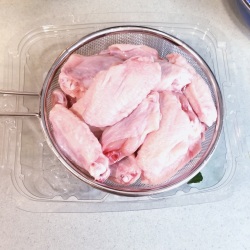
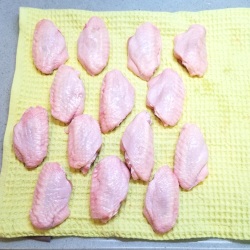
- In a ceramic bowl mix the following: 2T red miso, 2T honey, 1T mirin, 1T tahini, 1T sesame oil, 1t soya sauce and 1t turmeric. You can also add 1t of liquid smoke if that is your preference. (nb. the T’s for the pastes are heaped ones)
- As many of these ingredients are from the fridge you will need to microwave the mixture for about 15 seconds before they will can mix well. Alternatively, put the bowl in a larger bowl of hot water for a while. Stir and mash down with the bottom of a table spoon until all the lumps are gone and you end up with a smooth paste.
- Place the wings in a gallon zip lock and add the marinade. Squeeze out most of the air and then massage the bag and roll it around to get the marinade evenly over all the wings.
- Place the bag flat in the fridge overnight. Some water will be drawn out from the wings making the marinade a bit more watery, that is normal. Flip the bag over once every 6 hours or so to ensure the curing is even.
- The next day the wings will be cured. Arrange them on a wire rack in a tray(s) and allow the wings to warm to room temperature. The wings should not be touching each other. Don’t leave any splotches of marinade on the wings as these will become black patches of burnt skin as the excess sugar carbonizes in the oven.
- Preheat your oven to 180oC (350oF). Place the tray(s) in the oven for 20 minutes. The time may vary a bit from oven to oven, so decide when the wings are ready by visual inspection.
Notes
- The issue with most marinades is they are too watery and they drip off when they heat up in the oven, hence the need to paint on a layer of glaze at the end. That’s why this recipe emphasizes keeping the wings dry, so do not skip steps for 2 and 3. The tahini and turmeric play an important role in keeping the marinade thick so do not substitute them for something else. Also do not add any additional liquid to the marinade.
- You can also use a toaster oven. Set it to 200oC (390oF) and bake each batch for 25 minutes – the toaster oven is weaker than a regular oven, but can do the job – 8 wings at a time as shown in the photo.
- You can also skewer the wings and cook them over a BBQ.
- You can also use white miso, but you will need 3T instead of 2T as it is less salty. The white miso version is milder and sweeter. I typically use 2T white and 1T red when I make my wings.
Tags: BBQ, Chicken, Mirin, Miso, Sesame, Toaster Oven, Turmeric
(serves 8)
The combination of the intense savoury flavour and crunchy explosion of caviar just can’t be beat, but caviar can be a tad salty. In this recipe, this saltiness is perfectly balanced by the mild taste of egg salad to make the perfect amuse-bouche. There are just 5 simple ingredients, making this little package of tastiness incredibly easy to make. You can easily scale it up to serve several dozen guests if you need a dazzling canapé for a party.
Ingredients
- Caviar (1 bottle, 80g)
- Eggs (4)
- Shallots (1)
- Brioche (8 mini slices)
- Mayonnaise
Preparation
- Hard boil 4 eggs (i.e. 12 minutes or more). Allow the eggs to cool in cold water and then de-shell them. You can boil the eggs anytime before and keep them in the fridge.
- Put the each egg through a wire egg slicer three times. On the first pass, slice the egg as per normal but hold on to the ends of the eggs to keep the egg together.
- On the second pass slice the eggs lengthwise. It will be harder to keep the eggs together so do the slicing carefully.

- For the third pass you also slice the egg lengthwise but after rotating them 90 degrees. Hold the slicer over a large bowl to catch the falling bits as the egg will basically fall apart after you are done. The idea is to end up with little cubes of egg white. The yolk will disintegrate but that’s fine.
- Finely (and I mean finely) dice one shallot. You can use a quarter of an onion if you don’t have shallots.
- Add 2 heaped T of mayonnaise, the diced shallot, 0.5t sugar and a generous sprinkle of pepper to the diced egg and mix until the yolk has melted into the mayonnaise.
- Add half the caviar to the egg salad and mix some more. Place the bowl into the fridge for about an hour.
- Divide the caviar egg mixture onto the brioche. The brioche can be lightly toasted, or left untoasted if fresh.
- Decorate each amuse-bouche with the remaining caviar and serve while cold.
Notes
- Caviar is not as expensive a delicacy as you might think, all you need to do is use a caviar made from a fish other than sturgeon. The cheaper varieties taste perfectly fine and in any case you might not want to use top grade caviar as a flavouring ingredient. The bottle I used (pictured right) was made from herring roe and has a retail price of under ten dollars, as will many other varieties.
- Besides brioche you can use any number of other things as the base. Be it a pastry or bread, just make sure it is not of the salty type. The Blini (essentially a mini pancake, second photo) or a Yorkshire Pudding are some alternatives.
- The amount of caviar you reserve for decoration will determine the colour of your amuse bouche. If you mix the whole bottle of caviar in you will get a darker look as per the Blini photo.
- For some colour you can add some chopped chives. The stark green specks will make the amuse-bouche look even more attractive. I really should have done that for the photo.
- In case you were wondering, no that is not a giant ball of caviar in the top photo. It’s an optical illusion. It looks like a large slice of bread on a regular plate but its actually a slice of a mini brioche loaf on a small plate.

Tags: Amuse-bouche, bread, Brioche, Caviar, Eggs, Mayonnaise
(serves 6)
On a whim I decided to combine two of my favourite Chicken and Rice recipes, Chicken and Porcini Risotto and Chicken A La King. It turned out to be yet another match made in culinary heaven. The rich nutty flavour of porcini goes very well with the special brand of sweetness that comes with capsicum. The recipe also uses brined chicken breast to keep the chicken extra tender and separate from the rice.
Ingredients
- Dried Porcini Mushrooms (30g)
- Arborio Rice (1.25 cups)
- Brown Mushrooms (150g)
- Chicken Wings (4)
- Chicken Breasts (2 halves)
- Capsicum a.k.a. Bell Pepper (2)
- Onion (1)
- Garlic (1T minced)
- Butter (50g)
- Grated Parmigianino-Reggiano (1/2 cup)
- Cream Cheese
- Rosemary
Early Preparation
- Brine and poach chicken breasts as per the procedure given in this post. You can do this ahead of time and then warm up the chicken breasts in the hot stock before slicing them.
- Simmer 4 chicken wings in 4 cups of water with half an onion and 1t salt. Continue simmering until the meat is practically falling off the bone, adding water is necessary. You can also use 8 mid joints. Start making the stock at the same time you begin the brining.
- You also need to soak your porcini in 2 cups of water. Use cold water, as hot water will give the porcini a slight rubbery texture after it rehydrates. Keep in the fridge.
Preparation
- Bring your chicken stock to a slow simmer. Add the juices from the poached chicken breast and the porcini water (but not the porcini itself) to the stock pot.
- Cut the capsicums in half and remove the stem, core and seeds. Cut the tops and bottoms off and add them into the stock. Cut the sides into 1/4 inch squares and set them aside.
- Cut the brown mushroom into thick slices.
- Mince the garlic and julienne the remaining half of the onion into1/8 inch pieces. In a large pan, fry the onion bits on low heat in 2T of oil until they become yellow and limp. Add the garlic and continue pan frying for a minute.
- Turn up the heat on the pan and add the rice into the pan, stirring well.
- After another minute, add a ladle of stock (liquid only) to the pan and reduce the heat to produce a low simmer. Add the capsicum pieces to the pan at this stage.
- Stir until the risotto begins to dry, then add another ladle of the hot chicken stock. Stir frequently to prevent sticking. The stock pot must be kept simmering to avoid shocking the rice. Continue doing this for about 20 minutes.
- In the meanwhile grate the Parmigianino finely. Cut ¼ of a block of butter into 1 cm cubes and mix it with the grated cheese. Allow the butter to soften out in the open. This forms the mantecatura.
- Dissolve 1T of cream cheese in the last ladle of hot stock before adding it to the pan. Add both the brown mushrooms and the porcini at this stage.
- When your risotto is al dente you can let it almost dry up, after which you turn off the heat. Total simmering time varies a bit with the type of grain you are using, so rely on taste and appearance to decide if the risotto is done and not a timer.
- Stir in the mantecatura and let the risotto rest with the cover on for five minutes. Slice the Chicken breasts.
- After tasting, you may add a bit of salt or more grated cheese to the risotto as a final adjustment if you deem necessary. Arrange the sliced chicken over your plated risotto. Garnish with black pepper.
Notes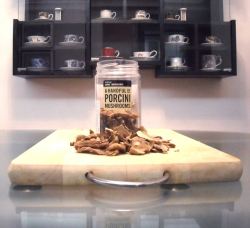
- My first risotto recipe contains many of the finer points on making risotto, which I have opted not to repeat here. You should refer to that post if you don’ make risotto often.
- Capsicums comes in 4 different colours which have different tastes. Red is sweet and easiest on the taste buds, Green is an acquired taste as it is less ripe and bitter. Orange and yellow capsicums are in between the two. I would recommend you use red and orange for this dish.
- For reference these are my Chicken A La King and Porcini and Chicken Risotto recipes.
Tags: Capsicum, Chicken, Italian Cuisine, Mushroom, Parmigiano-Reggiano, Porcini, Recipe, Rice, Risotto
(serves 4)
Tamagoyaki is the sweet omelette in the shape of a brick that you find on a Sushi platter. At home you can serve it as an amuse-bouche or a side dish. Tamagoyaki only requires a few simple ingredients but the typical method of making them can be technically demanding, requiring the rolling of multiple omelettes into a square Swiss roll on a hot pan before they fully cook. This takes lots of practice to get right as you have to work deftly. Fortunately there is an easier way for the novice that results in a perfect Tamagoyaki the first time and every time, the Stacking Method.
Ingredients 
- Eggs (4)
- Mirin
- Hon Dashi
- Sugar
- Nori (Dried Seaweed Sheet) – optional
see notes below for alternatives to
Hon Dashi and Mirin
Preparation
- In a large bowl, dissolve 1T of sugar and 1 flat t of Hon Dashi granules in 1/4 cup of warm water.
- Add 4 eggs and 2T of Mirin to the bowl and beat the mixture until it becomes a fairly uniform yellow colour.
- Use a small pan, a pan that has a flat bottom. Place it on very low heat. Add a few drops of oil and spread it around the pan.
- Ladle into the pan enough egg mixture to cover the whole pan without you having to tilt it. If the egg bubbles, splutters or gets cooked instantly, then pan is too hot. When the egg is almost cooked, flip the slice over to cook the other side. Next, flip the omelette sheet onto a plate and leave the pan off the fire for the time being. The omelette should be of the same thickness throughout, which is why the pan needs to be flat.
- Add a new ladle of egg mixture to the pan and put it back atop the flame. When the egg is almost fully cooked and only a thin film of raw egg is left on top, remove the pan from the fire. Using the back of a spoon spread the remaining raw egg evenly over the entire surface of the omelette sheet.

- Stack the first omelette sheet onto the one in the pan and return the pan to the fire. Press down with a flat spatula to ensure the raw egg is evenly distributed and after about ten seconds when the two sheets have fused into one, flip them back onto the plate.
- Repeat steps 5 and 6 adding more layers until almost all the raw egg mixture is used up and you end up with a block of Tamagoyaki as shown here. During the whole process add oil as required.
- Cut the block exactly into two halves. Smear a thin film of the remaining raw egg mixture on the top of one half-block and place the other half-block back in the pan, again on low heat. Next, position the hot block onto the other block with the cut ends on the same side and press down firmly. The idea is to let the hot egg cook the film of raw egg to cement the two blocks together.
- Allow the new tall block to cool and then wrap it in cling film. Sandwich it between two plates in the fridge. When the Tamagoyaki is cold, pad it dry with some kitchen towels, trim away the uneven bits at the edges and then cut the block into mini-bricks.
- Wrap each brick with a strip of dried Nori seaweed. The Nori should overlap at the bottom and a dab of water will suffice to join the two ends. This allows your guests to eat their Tamagoyaki with their bare hands if they wish.
Notes
- Ideally you should use a Makiyakinabe pan. This is a pan that has three vertical sides and is rectangular in shape, as shown here. Modern ones are now made of non-stick material. Your next best alternative is one of those small pans for frying one egg at a time.
- You definitely want to avoid burning the egg. A slightly browned patches are ok, but no more than that. You can notice in the top picture there is a brown line running along my Tamagoyaki, which is what will happen if your fire is too strong. Using a low flame may not be enough. Move the pan away from the fire often and make frequent use of the residual heat to cook the egg. Also, only pour in the raw egg mixture after removing the pan from the fire. Patience wins the day.
- You also want to cook the egg evenly. To do this move the pan around so the fire is not concentrated on one spot for too long. This also prevents the egg from getting burnt.
- You can skip step 8 depending on how big your pan is, how many Tamagoyaki bricks you want to end up with and how tall you’d like them to be.
- If you have no Hon Dashi, you can substitute in 1/4 cup of any kind of (salted) stock you fancy.
- If you have no Mirin you can boil 4T Sake with a dab of maple syrup down to 2T to make your own substitute.
- If you are into Japanese egg recipes, two others I have on this site are: Steamed Chawanmushi and Runny Yolk Eggs for Ramen.
Tags: Egg, Hon Dashi, Japanese Cuisine, Mirin, Nori, Sushi
(serves 2)
Cassoulet is a hearty meal-in-one dish of poultry, pork and beans in a tomato sauce from Languedoc, in the south of France. This is my simplified method for making a Cassoulet using everyday ingredients like chicken legs and baked beans. It’s not exactly the same as what you’d find in Toulouse but I think you’ll find its a close enough imitation as long as you’re not French. More importantly my recipe only takes 1 hour to prepare and cook instead of a whole day if you were to do it ‘properly’.
Ingredients 
- Chicken Leg with Thigh (2)
- Pork Sausages (2)
- Pancetta (100g)
- Onion (1/2)
- Shallot (4)
- White Wine (1/2 cup)
- Baked Beans (1 can, small)
- Oxo Beef Cube (1)
- Tarragon
- Thyme
- Coriander Seed Powder
Preparation
- Peel the shallots but keep them whole. The half onion should be cut into 3 wedges.
- Trim (and retain) any excess skin and visible fat from the chicken. Season the chicken legs with a dusting of pepper, but no salt.
- Fry 100g of diced pancetta in a pan on low heat with 1T oil (goose fat if you have any) together with the chicken trimmings and the two pork sausages.
- When the fat from the pancetta begins to render, add the shallots and onions to the pan. Move the contents of the pan around to prevent them from getting burnt until the onion breaks up into soft pieces.
- Pour everything from the pan into a casserole. The Casserole should be tall enough to prevent boiling over. Drain the oil back into the pan and turn up the heat.
- When the pan is hot, brown the chicken in it. The chicken shouldn’t be in the pan so long that it gets cooked completely.
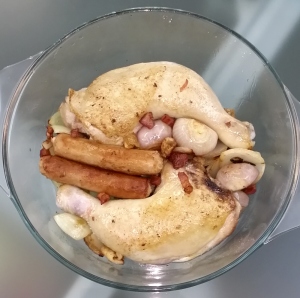
- Place the browned chicken in the casserole as well and arrange all the contents snugly as shown. Sprinkle some black pepper over everything.
- Preheat your oven to 180oC (350oF).
- Melt 1 Oxo Beef cube in 3/4 cup of hot water and use this stock to deglaze the pan. Turn on the heat again and add 1/2 cup of white wine and the can of baked beans. While the mixture is being brought to a boil, add 1T Tarragon, 1T thyme, 1t coriander seed powder.
- After the sauce has been boiling for half a minute, pour it into the casserole. Place the casserole in the oven for 25 minutes, uncovered. The cooking time may vary slightly, you’ll know its time when enough of the liquid has evaporated and the chicken is partially exposed.
- You may serve your cassoulet immediately but it can also be put aside and reheated later, it will taste just as good. It is traditional to serve the whole casserole (as per below), with the individual plating done at the table. The dish has a lot of sauce, so it goes well with baguette or some other kind of bread.
Notes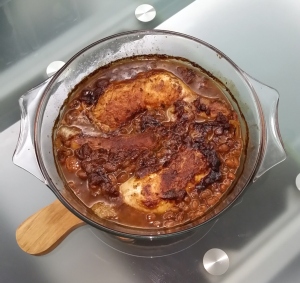
- If you haven’t cooked an authentic cassoulet before, here is a summary: Cassoulet is usually served with Duck Leg Confit instead of chicken and this is to be roasted separately. You’ll also need Toulouse Sausages which are hard to find, plus you also have to soak beans ahead of time and cook them for a really long time to get them soft. Other typical cassoulet ingredients that I left out include tomatoes, celery, carrots and laminated pork.
- The nice thing about canned baked beans is they come pressure-cooked and their sauce has the same effect as the gelatin you would normally get from cooking pork skin in the Cassoulet for a long time. Baked beans are thus the secret to the greatly reduced cooking time.
- Speaking of pork skin, if you’d like you could try adding pieces of smoked ham hock if you so desire; treat them the same as the sausages.
- Some recipes sprinkle breadcrumbs on the cassoulet to form a crust, but I don’t belong to the crust camp.
- You can use a pot or pan instead of glass or ceramic ware as long as they come with an all metal handle. Be warned – if you use an oversized sized container the liquid level will be too low to cover the chicken initially and it will get burnt. A solution is to bake the casserole covered and then again uncovered at the end.
Tags: Beans, Chicken, French Cuisine, Pancetta, Sausage, tomatoes

 Cut the lobster meat into bite sized morsels. drain off all the excess brine by leaving the lobster meat in a strainer.
Cut the lobster meat into bite sized morsels. drain off all the excess brine by leaving the lobster meat in a strainer.























